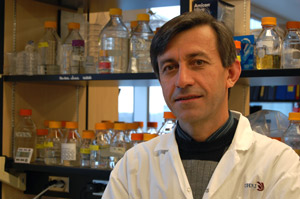Research Awards
Dr. Vahab Soleimani
Winner of the 2012 Dr. Ronald G. Worton Researcher in Training Award
 To pursue excellence in science, Dr. Vahab Soleimani has made a habit of travelling to new frontiers.
To pursue excellence in science, Dr. Vahab Soleimani has made a habit of travelling to new frontiers.
His first notable passage in this pursuit took place during his second year of university, when he made his way to Turkey from Iran, leaving behind his home and family in the Kurdish region of the country's northwest. At the age of 21, when Dr. Soleimani arrived in Ottawa as a refugee in 1989, his "priority was to get back to science," he says.
Here, after re-acquiring his high-school qualifications, he completed his entire post-secondary career at the University of Ottawa, receiving his B.Sc. (Hon) in biotechnology, and his M.Sc. and PhD in molecular biology, graduating in 2006.
Dr. Soleimani was attracted to molecular biology because of the new world of DNA technology. "For the first time we were able to manipulate DNA and move it around and do all kinds of wonderful things," he says. "This recombinant DNA technology was one of the driving forces that stimulated my interest in the research I do."
Until 2007, all his schooling and experience was in plant genomics, but he became inspired to use his acquired skills to help discover how stem cells work at the molecular level. "It was a new frontier opening in regenerative medicine, and the potential of harnessing the properties of stem cells and making them into therapies for all kinds of diseases is just enormous," says Dr. Soleimani.
In 2007, this led him to Dr. Michael Rudnicki's lab in the Regenerative Medicine Program of the Ottawa Hospital Research Institute, where he has led the team's genomics project to describe proteins involved at different stages of muscle generation.
He has recently published two papers in high-impact journals that describe the molecular mechanisms of muscle stem cells' self-renewal and differentiation.
In a paper published in Developmental Cell, he and his colleagues revealed how two very similar proteins, Pax3 and Pax7, can play quite distinct roles in muscle development and regeneration. The research shows that, while the two proteins recognize the same DNA sequence, Pax7 binds more strongly to these sequences, which explains why Pax7 regulates a much larger set of muscle stem cell genes than Pax3.
In the second paper published this year, Dr. Soleimani and colleagues describe a novel molecular network that directs muscle stem cells to either create more stem cells or commit to differentiation and eventually become mature muscle fibres. The network involves two proteins called Snai1 and Snai2, as well as other genetic regulators called microRNAs. This discovery, published in Molecular Cell, could help with the development of novel regenerative approaches to treat muscle diseases. It also has implications for the understanding of certain cancers with high levels of Snai1, Snai2 and related proteins, such as ovarian carcinoma and lung adenocarcinoma.
Both studies, done while he was a postdoctoral fellow, provide important insight into the genetic regulation of muscle regeneration.
In addition to making these important discoveries in his field, Dr. Soleimani is a highly collaborative team player and leader whose contributions and thoughts are highly regarded by his peers. Still working on muscle stem-cell biology in Dr. Michael Rudnicki's lab, Dr. Soleimani has set his sights on his next frontier — establishing his own laboratory and continuing his research on stem cells.
